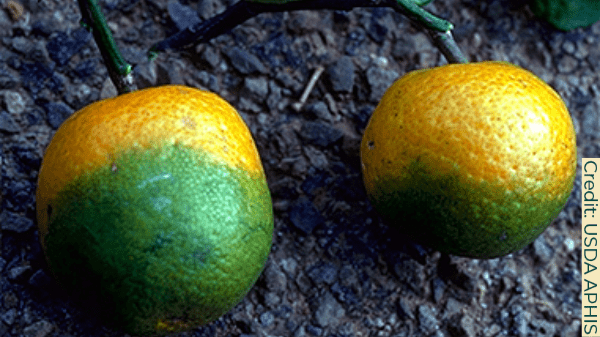Florida’s Oranges Are in Crisis - You Can Thank Climate Change for That
Orange juice from Florida used to be a breakfast staple. Now, it’s starting to look more like champagne—a luxury item for special occasions. As climate change intensifies, Florida's orange market is caught in the turmoil. Since the 1990s, the state's orange production has fallen 92.5%, dropping from 244 million boxes to just 12.15 million boxes by this year. The decline has many asking: How did a once-dominant powerhouse for the fruit end up here?
Florida is typically known for its hot, steamy, sunny climate with frequent thunderstorms, but as climate change continues, its conditions become hotter and steamier, and its storms are more frequent and severe, harshly impacting the state's national fruit. The frequency of such intense conditions has made the fruit vulnerable to citrus greening disease: a bacterial disease spread by tiny, sap-sucking insects called psyllids (pronounced sill-ids).
An example of citrus greening on oranges
During warmer weather months, the insects feed on young citrus shoots and leaves, injecting bacteria that cause citrus greening disease (HLB). The disease causes trees to produce bitter, small, misshapen fruit that appear about 2-3 years after contamination, making it significantly difficult to detect. The insect thrives under warm conditions, and as Florida is having more and more milder winters, psyllids are enabled to continue reproducing and feeding on the plant. Frequent severe storms and hurricanes only exacerbate the problem, carrying the insects into new groves and regions just to spread the disease more. Since first hitting in 2005 and the presence of back-to-back hurricanes from 2021 to 2024, the disease has spread to every citrus-growing county in Florida, putting the orange belt on the brink.
The numbers back it up. In Ruskin, Florida, this past year brought nearly a month’s worth of extra days above 90°F, with average temperatures running more than 2 degrees hotter than normal. Cold snaps—which once helped keep pests like psyllids in check—have completely disappeared. The chart below shows how climate risk has spiked alongside these hotter, steamier conditions, creating the perfect environment for citrus greening to spread.
Figure 1. Climate risk in Florida groves is climbing fast. The chart shows the percentage of days rated “high-risk” (red) through 2025–26. Spikes in spring and summer align with hotter months, when psyllids thrive and citrus greening spreads most aggressively. With more frequent high-risk periods and fewer low-risk days, Florida’s orange belt faces a climate stacked against recovery.
Figure 2. Climate anomaly indicators for the selected timeframe compared with historical averages. The region experienced an average temperature increase of 2.45°F (3.36% above normal), with 86 days above 90°F—28 more than normal (+48.7%).
The spread of the disease due to warmer weather is so bad that the United States Department of Agriculture projects that the U.S. citrus output is at its lowest in 88 years. But this issue isn’t just isolated in Florida; Brazil is feeling it too. The country is one of the world's top producers of the crop, yet it lost 18% of it due to an El Niño weather pattern and greening, causing the price of orange juice concentrate to more than double in just one year.
Florida’s groves aren’t just producing fewer oranges—the fruit that do survive are often smaller, misshapen, and bitter due to citrus greening. The lack of viable oranges has influenced wholesale prices to climb sharply. Retail orange juice, which depends on the dwindling harvests, has nearly doubled in price, rising from $2.30 in 2020 to $4.50 in 2025 for a 12-ounce bottle. From orchards to grocery aisles, the trend is clear—the fruit is under pressure.
Rising temperatures and citrus greening have left Florida's orange belt vulnerable. But this isn’t just a story about oranges. Climate change is slowly but surely reshaping what we eat, threatening not only our crops but also our identity tied to them as well. Florida oranges were once so abundant that they defined the state. Now, they are becoming a luxury.



